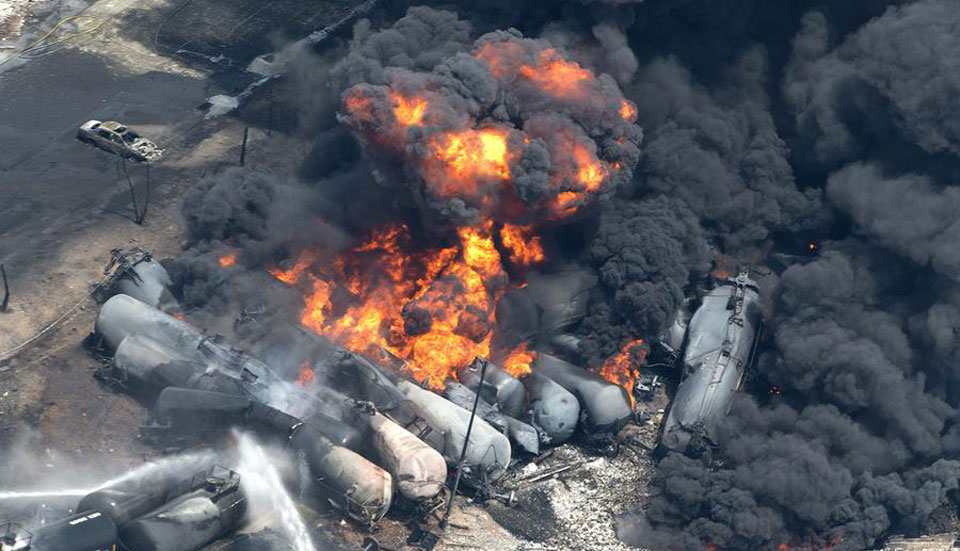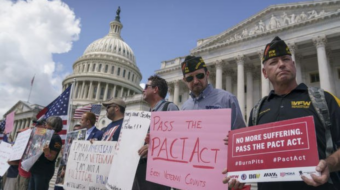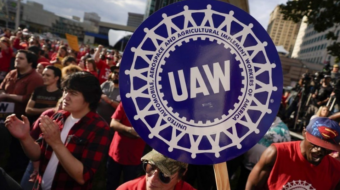
WASHINGTON—Remember the Lac-Mégantic rail disaster in Quebec six years ago? Donald Trump apparently doesn’t, but rail workers, citizens, and lawmakers concerned about the danger of a natural gas explosion do – and that’s one big reason they’re trying to stop a Trump scheme to ship liquified natural gas by rail in its tracks, literally.
At issue is a plan from Trump’s Transportation Department, specifically from its Pipelines and Hazardous Materials Safety Administration (PHMSA), to let miles-long trains of tank cars filled with liquified natural gas roll through towns and cities.
In an executive order, Trump told DOT on April 10 to draft a rule to let those LNG tank-car trains roll. Liquified natural gas usually goes long distances by pipelines. So does crude oil, but it went by train in Lac-Megantic. Catastrophe ensued.
On July 6, 2013, a 72-car oil train’s brakes failed and it started to roll seven miles downhill from the siding where it was parked until it crashed, derailed, exploded, and blew up downtown Lac-Mégantic. The center of town was destroyed and 47 people died.
Liquified natural gas, also known as methane, is more dangerous, Railroad Workers United – an organization of rank-and-file union freight rail workers nationally – told the PHMSA. So did most of the 2,947 comments on the Trump scheme, which one transportation publication said Trump promulgated at the behest of energy companies and the railroads.
So did Reps. Peter DeFazio, D-Ore., chair of the House Transportation and Infrastructure Committee, and Tom Malinowski, D-N.J., whose district is crisscrossed by rail freight lines. DeFazio called Trump’s LNG shipment scheme “beyond absurd.”
After Trump’s executive order, where he compared LNG to “cryogenic” cold liquids, PHMSA put out a 23-page draft environmental assessment advocating giving a waiver to Energy Transport Solutions, LLC, a natural gas company, to let six 100-LNG-tank-car trains roll. The tank car train routes were not specified.
The kindest word the rail workers, the citizens, and the lawmakers could find to describe the environmental assessment – which is not a full-blown environmental impact statement the government usually requires for major projects — was “inadequate.”
The unionists told PHMSA that “rail shipments of LNG would pose dramatic health, safety, and environmental risks to railroad workers and communities across the United States.”
“LNG train derailments could cause fires and explosions, property damage, mass injuries and fatalities – impacts that are largely ignored in PHMSA’s cursory 23-page analysis.”
“As an organization of working rank and file railroad workers from all crafts and all carriers, Railroad Workers United is deeply concerned about the casual attitude towards shipping LNG by rail. Over the course of the last six years or so we have witnessed the danger inherent in shipping Bakken crude oil by rail with limited oversight and regulation, a danger that continues to this day. “
While their letter opposing Trump’s planned waiver to ship the liquified natural gas by rail didn’t mention the Lac-Mégantic explosion by name, the unionists alluded to it.
“The proposal to ship LNG by rail likewise is inherently dangerous for train crews, trackside communities and the public at large if it is not moved in a safe manner. Most of the oil trains which have crashed over the last six years or so — resulting in spills, fires, and explosions — were in fact made up of DOT-113C120W tank cars, ones of the type that apparently are being proposed now for LNG trains,” they noted.
The union workers aren’t the only people upset by Trump’s scheme.
“In its never-ending quest to put profit ahead of people, the Trump administration is now trying to bypass long-standing requirements for transportation of LNG by putting it into 100-car trains that roll through densely populated areas at upwards of 50 miles per hour,” DeFazio said. “
“This plan is beyond absurd. Should even one tank car get punctured, the results could be devastating.”
DeFazio attached an amendment to the House version of the Transportation Department money bill banning PHMSA from going ahead with Trump’s scheme to let the LNG-filled tank cars roll. But the GOP-run Senate has yet to consider the legislation.
Most of the individual letters to PHMSA opposed the Trump scheme, too.
“Please do not transport natural gas through rail. Not only is it dangerous but it prevents many skilled tradesmen from safely constructing pipelines for transporting natural gas, thus financially harming families and communities,” John Marti wrote from Henderson, Texas.

“In case of an accident, LNG-by-rail can cause catastrophic fires and explosions. The permit would allow LNG unit trains to pass through densely populated cities and suburbs. In case of an accident, first responders would be unable to control and contain the incident. If an LNG tank car is caught in a fire and engulfed by external flames, a bomb-like explosion could result. And LNG trains would be vulnerable to terrorist attack,” wrote Marilyn Costamagna of Medford, Ore. Hundreds of identical letters marshaled by citizens groups said the same thing.
But the comment period on Trump’s scheme closed August 8, leading both the lawmakers and the unionists to take a second tack in their letters: If PHMSA is going to let the LNG-filled tank cars roll, there must be strict controls and tests of the cars to make sure – among other requirements – that they’re puncture-proof.
“LNG shall not be moved by rail unless it is moved in tank cars that have been crash tested to withstand puncturing,” Railroad Workers United wrote. “Many of the rail cars currently in service are not capable of safely transporting LNG and should not be used in this capacity.”
RWU also wants strong, electrically controlled pneumatic brakes on all the tank cars “as a means of possibly preventing a disaster.” And they want to limit the trains to 50 tank cars, not 100, and to have two-person crews as a safety measure. A key flaw of the Lac-Mégantic 72-car train was that it had only an engineer. The Quebec provincial government had eliminated the requirement for a second worker on that oil train – who could have stopped it.










